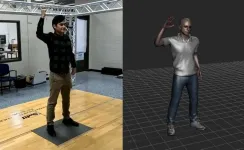(Press-News.org) Relaxation techniques may help lower high blood pressure—at least in the short term—but the longer term effects are unclear, finds a pooled data analysis of the existing research published in the open access journal BMJ Medicine.
And the risk of bias in the existing body of research means that further, more rigorously designed and longer studies are needed to confirm whether these techniques have a constructive role in the treatment of high blood pressure, conclude the researchers.
High blood pressure affects around a third of 30-79 year olds and is one of the leading attributable causes of deaths in both men and women, note the researchers.
While drugs are available to treat the condition, adherence to them is poor, generating interest in alternative approaches, such as relaxation techniques, to reduce one of the major risk factors for high blood pressure—high stress levels.
But it’s far from clear which of these methods, which can include breath control, mindfulness, yoga, Tai Chi, and biofeedback, among others, might be most effective.
To build on the evidence base, the researchers scoured research databases for studies, published in English up to February 2024 that looked at the potential impact of relaxation techniques on high blood pressure (140/90 mm Hg and above) and elevated blood pressure (120/80 mm Hg and above).
They included 182 studies, 166 of which looked at high blood pressure, and 16 of which looked at elevated blood pressure (pre-hypertension).
Where possible, the researchers deployed network meta analysis, a statistical technique used to simultaneously compare the effects of several different ‘treatments’.
The pooled results of 54 studies showed that most relaxation techniques seemed to lower both systolic and diastolic blood pressure for people with high blood pressure after 3 or fewer months. The most commonly included interventions were breath control (13 studies), yoga/tai chi (11), biofeedback (8), progressive muscle relaxation (7), and music (7).
Compared with no intervention, breath control achieved a reduction of 6.65 mm Hg in systolic blood pressure (the first and higher number in a blood pressure reading), meditation a drop of 7.71 mm Hg, meditative movement, such as tai chi and yoga, a drop of 9.58 mm Hg, and mindfulness a drop of 9.90 mm Hg.
Music was also associated with a fall of 6.61 mm Hg, progressive muscle relaxation with a fall of 7.46 mm Hg, and psychotherapy with a reduction of 9.83 mm Hg. Combined techniques were associated with a drop of 6.78 mm Hg in blood pressure.
There was no statistical evidence of effectiveness for any technique after 3 to 12 months and the certainty of the evidence was very low. The most commonly included techniques at this timepoint were biofeedback (7 studies), yoga/tai chi (4), and progressive muscle relaxation (4).
Very few studies included long term follow up of 12 months or more, and of the 3 included in the network analysis, the results showed that compared with no treatment autogenic (self directed) training might lower both systolic and diastolic blood pressure, but the certainty of the evidence was low.
There was no statistical evidence of effectiveness for other treatments assessed at this time point, including biofeedback, progressive muscle relaxation, and techniques involving a combined approach.
Limited data were available for elevated blood pressure: only two studies compared relaxation techniques with no treatment/usual care and the effects on systolic blood pressure were small.
The researchers note that the descriptions of relaxation interventions were sometimes incomplete or sparse, there were few data on costs and cost effectiveness, and most of the included studies didn’t report information on the risk of cardiovascular disease/events/deaths.
But they suggest: “The results of our systematic review and network meta-analysis indicate that relaxation or stress management techniques might result in meaningful reductions in blood pressure at up to three months of follow-up.”
But they caution: “Uncertainty exists about this effect, however, because of the risk of bias in the primary studies, the potential for publication bias in this area, and imprecision in the effect estimates, meaning that the observed changes in blood pressure might be too small to affect cardiovascular or cerebrovascular outcomes.”
And they add: “Hypertension is a chronic condition, likely to require long term drug treatments or behavioural changes. As such, interventions that are used for a brief period, or provide only short term benefits, are unlikely to be clinically useful.
“Too few studies exist, however, to assess whether the beneficial effects of relaxation are maintained when the techniques are practised for longer than three months. Future studies must clearly report whether participants were still using relaxation methods at the time of the outcome assessment, with details on adherence to the relaxation schedule. These factors might strongly influence the effectiveness of the different relaxation and stress management techniques.”
END
Relaxation techniques may help lower high blood pressure—at least in the short term
But longer term effects unclear and bias likely in much of the existing research
2025-04-08
ELSE PRESS RELEASES FROM THIS DATE:
Bans on outdoor junk food ads derailed by industry lobbying
2025-04-08
Plans to ban junk food adverts from bus stops and billboards to protect public health are being stymied by advertising industry lobbying, reveals an investigation published by The BMJ today.
The BMJ sent Freedom of Information (FOI) requests to 52 of the 317 councils in England to uncover how advertising firms and lobby groups were targeting council policies to restrict ‘out-of-home’ junk food adverts.
McDonald's was the largest out-of-home advertiser in 2024 with a spend of £86.3 million, according to trade body Outsmart. Others in the top 20 include Pepsico, Coca Cola, KFC, Mars and Mondelez, the US owners of Cadbury.
The FOI responses ...
Prescribing parkrun is a retrograde step, argues doctor
2025-04-08
General practitioners are now “prescribing" parkrun for their patients as part of a social prescribing initiative to promote preventative care. But in The BMJ today, Dr Margaret McCartney argues that turning parkrun into a prescription medicalises a walk in the park and is a retrograde step.
Parkrun is an organised, timed, and free 5 km run, jog, walk, or wheel on Saturday mornings—in parks, on beaches, or on trails around the world but mainly in the UK, where it originated.
Parkrun ...
AMS science preview: Fire weather, bumpy hurricane flights, climate extremes and protests
2025-04-08
The American Meteorological Society continuously publishes research on climate, weather, and water in its 12 journals. Many of these articles are available for early online access–they are peer-reviewed, but not yet in their final published form. Below are some recent examples.
JOURNAL ARTICLES
Multi-factor Change in Western U.S. Nighttime Fire Weather
Journal of Climate
Western fires become less prone to “lay down” at night. Wildfires typically calm down at night–a crucial break for firefighters–yet firefighter and satellite measurements confirm increased nocturnal fire activity in the western U.S. from 1980 to 2020. This study shows increases in meteorological ...
People’s brain activity shows their political affiliation while buying food, study shows
2025-04-08
People’s political affiliation can be shown in their brain activity when they carry out mundane chores such as buying food, a new study shows.
How the brain reacts to food purchasing decisions can be used to determine people’s political affiliation with almost 80 per cent accuracy, researchers have found.
Although buying eggs and milk can lack emotional potency and political content, understanding how the neural systems lead people to make indistinguishable choices may help to explain the broader mechanisms of partisanship.
Experts from Iowa State University, the ...
Phage therapy at a crossroads: global experts unite in Berlin for groundbreaking 2025 Congress
2025-04-08
Berlin, Germany – April 7, 2025 — With antimicrobial resistance rising as one of the world's most pressing health threats, the 8th World Congress on Targeting Phage Therapy 2025 will bring together the global phage community to shape the future of infection control and microbiota modulation. Taking place on June 10–11, 2025, at the DoubleTree by Hilton Berlin Ku'damm, this landmark event will showcase cutting-edge research, real-world clinical insights, and groundbreaking applications of bacteriophage therapy across medicine, oncology, agriculture, and industry.
Strategic Importance
Phage therapy has entered a new ...
SwRI launches BEAMoCap™ markerless motion capture for 3D animation in gaming, film
2025-04-08
SAN ANTONIO — April 8, 2025 – Southwest Research Institute has launched a new markerless motion capture system that simplifies how film and gaming studios capture human movement for 3D animations. SwRI’s Biomechanical Evaluation and Animation Motion Capture (BEAMoCap™) tool converts video into realistic 3D animations without the conventional marker suits worn by actors.
BEAMoCap won a 2025 Technology Innovation Award from the National Association of Broadcasters (NAB). SwRI staff accepted the award at ...
Open access institutional membership - Xiamen University and Bentham Science
2025-04-08
Xiamen University (XMU) has joined the Bentham Science Institutional Membership Program. This membership enables XMU researchers to publish their articles as Open Access under the CC-BY 4.0 license at concessionary rates in any Bentham Science journal. Through collaborations with institutions and organizations worldwide, Bentham Science is committed to promoting open research and fostering scientific advancements in science, medicine, and technology.
Xiamen University (XMU), founded in 1921, is a prestigious comprehensive university ...
Two mixtures of common food additives, including aspartame, sucralose, xanthan & guar gums, modified starches, carrageenan and citric acid, are linked with slightly increased risk of type II diabetes,
2025-04-08
Two mixtures of common food additives, including aspartame, sucralose, xanthan & guar gums, modified starches, carrageenan and citric acid, are linked with slightly increased risk of type II diabetes, per French cohort study of more than 100,000 adults
In your coverage, please use this URL to provide access to the freely available paper in PLOS Medicine: https://plos.io/3RkrNLv
Article title: Food additive mixtures and type 2 diabetes incidence: Results from the NutriNet-Santé prospective cohort
Author countries: France
Funding: see manuscript END ...
Certain food additive mixtures may be associated with an increased risk of type 2 diabetes
2025-04-08
Food additive mixtures are an everyday feature of our diets, especially through ultra-processed foods. Until recently, safety evaluations of these additives have been conducted substance by substance due to a lack of data on the effect of them ingested together. In a new study, researchers from Inserm, INRAE, Sorbonne Paris Nord University, Paris Cité University and Cnam, as part of the Nutritional Epidemiology Research Team (CRESS-EREN), examined the possible links between exposure to mixtures of ...
Mouse brains register the difference between touching something and being touched
2025-04-08
Though the sense of touch underlies how we and most other animals interact with the world around us, much remains unknown about how this sense is processed in the brain. Researchers from Heidelberg University and Ludwig Maximillan University Munich in Germany measured the neuronal activity differences between active touch and passive touch in mice. As reported April 8th in the open-access journal, PLOS Biology, the researchers find that active and passive touch are processed by different pathways in the brain.
Active touch can be thought of as grabbing something with your hand, while passive ...
LAST 30 PRESS RELEASES:
Scalable and healable gradient textiles for multi‑scenario radiative cooling via bicomponent blow spinning
Research shows informed traders never let a good climate crisis go to waste
Intelligent XGBoost framework enhances asphalt pavement skid resistance assessment
Dual-function biomaterials for postoperative osteosarcoma: Tumor suppression and bone regeneration
New framework reveals where transport emissions concentrate in Singapore
NTP-enhanced lattice oxygen activation in Ce-Co catalysts for low-temperature soot combustion
Synergistic interface engineering in Cu-Zn-Ce catalysts for efficient CO2 hydrogenation to methanol
COVID-19 leaves a lasting mark on the human brain
Scientists use ultrasound to soften and treat cancer tumors without damaging healthy tissue
Community swimming program for Black youth boosts skills, sense of belonging, study finds
Specific depressive symptoms in midlife linked to increased dementia risk
An ‘illuminating’ design sheds light on cholesterol
Who is more likely to get long COVID?
Study showcases resilience and rapid growth of “living rocks”
Naval Research Lab diver earns Office of Naval Research 2025 Sailor of the Year
New Mayo-led study establishes practical definition for rapidly progressive dementia
Fossil fuel industry’s “climate false solutions” reinforce its power and aggravate environmental injustice
Researchers reveal bias in a widely used measure of algorithm performance
Alcohol causes cancer. A study from IOCB Prague confirms damage to DNA and shows how cells defend against it
Hidden viruses in wastewater treatment may shape public health risks, study finds
Unlock the power of nature: how biomass can transform climate mitigation
Biochar reshapes hidden soil microbes that capture carbon dioxide in farmland
Reducing saturated fat intake shows mortality benefit, but only in high-risk individuals
Manta rays create mobile ecosystems, study finds
Study: Mixed results in using lipoic acid to treat progressive multiple sclerosis
Norbert Holtkamp appointed director of Fermi National Accelerator Laboratory
New agentic AI platform accelerates advanced optics design
Biologists discover neurons use physical signals — not electricity — to stabilize communication
Researchers discover that a hormone can access the brain by hitchhiking
University of Oklahoma researcher awarded funding to pursue AI-powered material design
[Press-News.org] Relaxation techniques may help lower high blood pressure—at least in the short termBut longer term effects unclear and bias likely in much of the existing research



